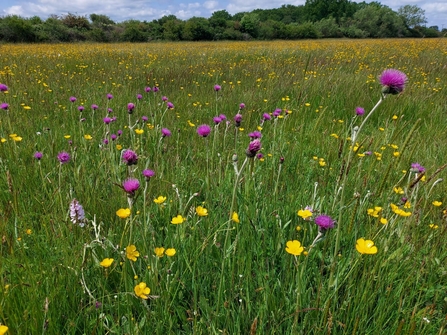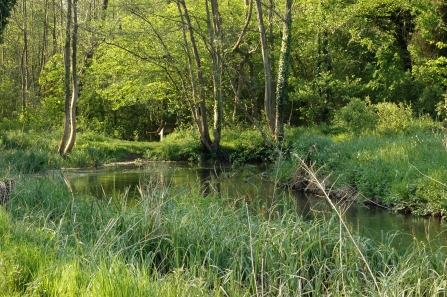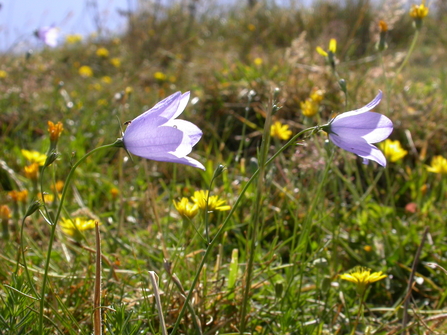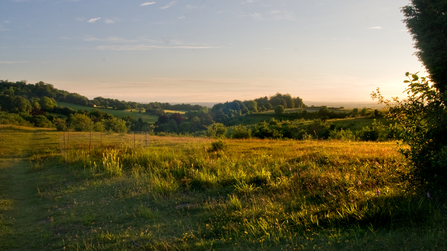BBOWT's Warburg Nature Reserve near Henley at the height of summer. Picture: Ric Mellis
Where to go in July
Meadow Brown on Gwent Levels © Neil Aldridge
Warburg Nature Reserve, Oxon
Nestled in the Chiltern Hills near Henley, Warburg delights its visitors any season with its stunning chalk grasslands and tranquil beech woodlands. In summer, the sun-soaked grasslands burst into bloom, showcasing a rich tapestry of wildflowers. July is peak orchid season here. BBOWT records up to 15 different species across the site. The scarce narrow‑lipped helleborine, in particular, flashes into bloom mid‑July in shaded beech woodland, often clustering near its limestone-rich soils. The cool, leafy shade offers a pleasant contrast on warmer days, while ponds in the valley shimmer with water violet and yellow flag iris.

Wild flowers at Asham Meads. Photo by Colin Williams
Asham Meads, Oxon
Just south of Bicester, sits Asham Meads – a 23‑hectare reserve near Otmoor that showcases a rare blend of botanical treasures across its damp meadows, 1930s oak plantation, pond, hedges, and scrub. Thanks to historic ridge-and-furrow agriculture, the meadows display alternating bands of wetter and drier turf. These rich flower meadows support a dazzling summer insect display. Marbled whites, small coppers, meadow browns, plus the rare black and brown hairstreaks flit along the blackthorn hedges.

Moor Copse by Helen Taylor
Moor Copse, Berks
Across in Berkshire, along the banks of the River Pang, remains one of BBOWT’s most varied woodland-meadow mosaics, Moor Copse. In July, it's alive with colourful wildflowers, busy butterflies, elusive moths, and skimming dragonflies, and is a true summer haven. Over 300 species of moth have been recorded here, a testament to the reserve's ancient woodland richness. The Coronation Meadow, a nationally recognised wildflower site, is at its peak in July, with meadow plants shimmering amid the woodland edge. Damp copses, coppice rides, and floodplain meadows create a tapestry of habitats that support this biodiversity.

©Bruce Shortland
Seven Barrows, Berks
To the west lies Seven Barrows - a nationally important site for both wildlife and archaeology. July is one of the best times to see its chalk grassland at its most vibrant. More than 150 plant species have been recorded here, including horseshoe vetch, chalk milkwort, chalk fragrant-orchid, harebells and clustered bellflower. It is impossible to say for certain what this countryside looked like when its Bronze Age inhabitants were constructing their burial mounds, known as 'barrows', but it was likely to have been covered by woodland. The now characteristic open, rolling grassland of the Berkshire Downs may have been one of the first areas to have been cleared by early humans. The terrain is mostly flat but uneven in places, so sturdy footwear is recommended.

Grangelands by Rob Lewis
Grangelands & The Rifle Range, Bucks
If you are searching for stunning displays of chalk grassland flora and insects, head across the county border to Grangelands & The Rifle Range in Buckinghamshire. On the sunlit slopes and gentle banks, you'll find an impressive array of orchids and warm expanses of wildflowers alive with buzzing bees, grasshoppers, and a kaleidoscope of butterflies that dance through the air along the Ridgeway path. Explore the ancient ridgeway and the wooded slopes of Pulpit Hill, with its prehistoric hillfort, for a mix of heritage and wildflower splendour.
Purple emperor by Tom Hibbert
Rushbeds Wood, Bucks
To enjoy an afternoon of sun and shade, head to the beautiful rides and open glades at Rushbed Woods. In July, make sure to scan the tree canopy for the fast-flying purple hairstreak, and keep your eyes peeled for the majestic purple emperor, white admirals, and glittering silver-washed fritillaries. Please ensure to stick to the marked paths. The woodland rides are carefully managed to nurture wildflowers, so trampling can easily damage these delicate ecosystems. Beyond the wood, explore the ancient, grass-filled meadows which add to the reserve’s summer charm.

